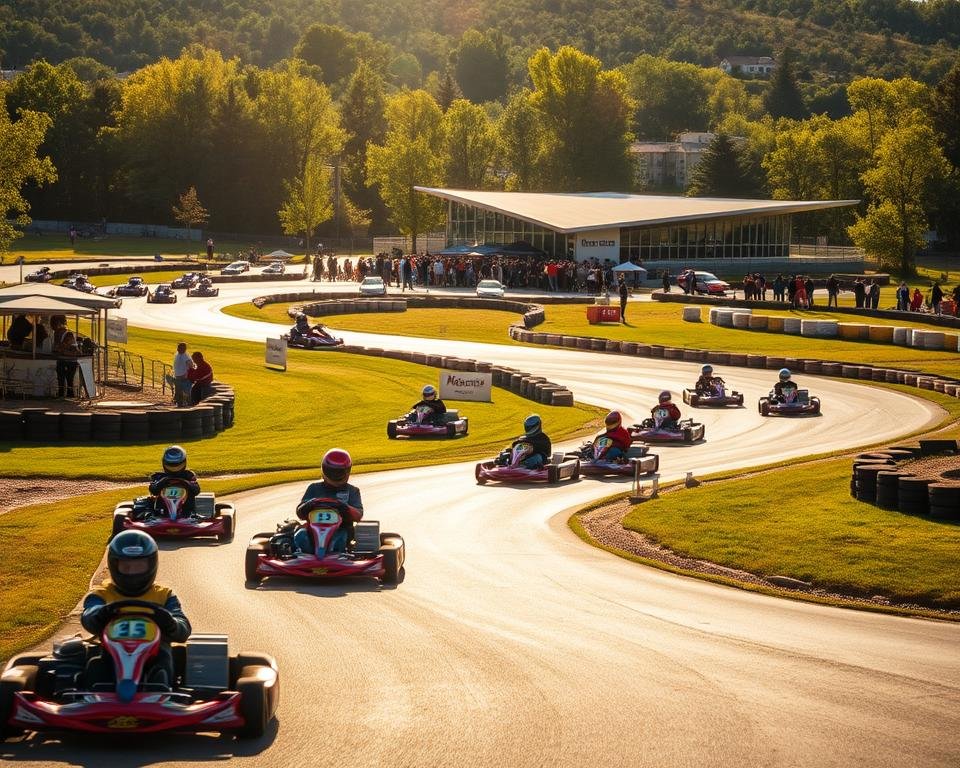Youth motorsport offers an adrenaline-packed entry point for youngsters eager to explore competitive driving. Karting serves as the foundation for future racing careers, with participants as young as 3-4 years old learning basic skills in specially designed kid karts. These starter vehicles feature controlled 1.5 hp engines, allowing safe speeds up to 25 mph while building confidence behind the wheel.
Families entering this sport will find multiple entry points across age groups. Junior divisions progress from beginner models to advanced karts as children develop their abilities. While initial investments range from $3,000-$10,000 for equipment and training, many families offset costs through resale opportunities and seasonal budgeting.
Safety remains paramount in youth motorsports. All participants require certified helmets, fire-resistant suits, and proper footwear – investments that grow with young drivers through different racing stages. Organizations like the World Karting Association enforce strict safety protocols to protect competitors while maintaining the thrill of competition.
Beyond the track, karting fosters valuable life skills. Young racers learn mechanical basics, sportsmanship, and strategic thinking. Many families utilize creative funding methods like local sponsorships or merchandise sales to sustain their racing season, which typically costs $500-$1,000 annually for regular participation.
This guide will help you navigate equipment choices, safety standards, and skill development pathways. Discover how karting serves as the perfect training ground for aspiring professional drivers while creating unforgettable family experiences at tracks nationwide.
Introduction to Youth Go-Kart Racing
From oval dirt tracks to winding road courses, youth motorsports offer structured programs tailored for young enthusiasts. These initiatives combine competitive thrills with skill-building frameworks, creating accessible entry points for families nationwide. Over 50 USAC-sanctioned clubs now provide organized events, blending professional standards with age-appropriate challenges.
Overview of Youth Racing Opportunities
Young drivers can choose between multiple kart types based on their interests. Offset models excel on oval surfaces, while road course versions tackle technical layouts with hairpin turns. Specialized categories like quarter midgets and bandoleros introduce advanced car control, with arrive-and-drive programs eliminating upfront equipment costs.
Regional circuits host events for various age groups, starting with putt-putt karts for preschoolers. As abilities grow, racers transition to faster machines with enhanced safety features. This tiered system ensures participants develop confidence and competence at every stage.
The Excitement and Benefits for Kids
Behind the wheel, children experience immediate feedback that sharpens reflexes and spatial awareness. Wheel-to-wheel competition teaches strategic thinking, while mechanical adjustments foster problem-solving skills. Many parents report improved focus in school subjects after their child begins racing.
The sport builds character through structured challenges. Young drivers learn accountability for equipment maintenance and respect for safety protocols. Family bonds strengthen through shared pit crew responsibilities and weekend adventures at local tracks.
How Kids Can Start in Go-Kart Racing: Getting Started Guide
Determining the right entry point requires matching physical development with vehicle capabilities. Most facilities recommend beginning between 5-6 years old using specialized karts with speed limiters. These starter models prioritize safety while teaching fundamental control skills.
Matching Age to Kart Specifications
Bambino Karts suit racers under 7 years old, featuring 50cc engines capped at 20 mph. At 48 inches tall, children graduate to Cadet models with 60cc powerplants reaching 65 mph. Pre-teens typically progress to Junior classes offering 100-125cc engines and advanced chassis designs.
Height requirements prove equally crucial as chronological age. Tracks mandate 56-inch minimums for full-size karts, ensuring proper pedal reach and visibility. Many clubs provide seat inserts and adjustable steering columns to accommodate growing drivers.
Launching the Racing Journey
First, visit local tracks offering rental programs. These trial sessions help assess interest without major investments. Next, enroll in certified training courses where instructors teach braking techniques and cornering strategies.
Seasoned coaches recommend renting equipment for 3-5 sessions before purchasing. This approach lets families evaluate commitment levels while children build core skills. Competitive entry should wait until consistent lap times and smooth overtaking maneuvers become second nature.
Finally, connect with regional karting communities through youth racing leagues. These networks provide mentorship opportunities and shared resources, creating supportive environments for skill development.
Developing Skills and Embracing Safety Measures
Mastering kart racing requires equal focus on ability development and protective practices. Young participants gain physical coordination while learning critical decision-making patterns, all within environments prioritizing well-being over pure speed.
Building Motor Skills and Responsibility
Steering through hairpin turns sharpens precise control as drivers coordinate throttle inputs with wheel movements. Braking zones teach split-second timing, while overtaking maneuvers develop spatial awareness. These physical skills transfer to everyday tasks requiring hand-eye coordination.
Responsibility grows through pre-race checklists and equipment maintenance routines. Young racers learn consequences of neglected tire pressures or loose harnesses. Flag recognition drills instill respect for track rules, creating safer environments for all participants.
Essential Safety Gear and Precautions
Certified helmets with full-face shields protect against impacts, while fire-resistant suits withstand extreme heat. Five-point harnesses keep drivers securely positioned, complemented by neck braces that minimize whiplash risks.
Tracks implement multiple safeguards beyond personal equipment. Crash-absorbing barriers line corners, and remote engine cutoffs let officials halt karts instantly. Speed governors adapt to age groups, ensuring safety scales with growing abilities.
Parents reinforce these measures through gear inspections and safety briefings. This layered approach makes youth karting statistically safer than soccer or basketball when protocols get followed consistently.
Navigating Tracks, Clubs, and Competitive Opportunities
America’s karting landscape offers diverse pathways for developing talent. Over 130 NHRA-sanctioned locations host junior drag events, while 50 USAC clubs provide quarter midget programs. These venues cater to various experience levels, from casual enthusiasts to serious competitors.

Finding Local Tracks and Joining Programs
Begin your search using official racing organization websites. Many facilities feature Honda-powered karts on 1/10th-mile asphalt ovals, with engines producing 2.5-6 horsepower. Indoor tracks often require 48-inch minimum heights for junior models.
Structured programs help young drivers build skills progressively. Arrive-and-drive options let families test different racing styles before investing. Clubs range from recreational groups to competitive leagues nurturing future professionals.
Track designs influence skill development. Technical courses demand precise steering, while oval layouts teach drafting strategies. Regional events serve as stepping stones to national competitions as abilities improve.
Consider time commitments carefully. Regular practice and travel demand family coordination. Building connections with experienced racers and mechanics accelerates learning while fostering community support.
Conclusion
Youth racing welcomes participants of all ages, proving that passion matters more than birth years. While many drivers begin early, some professionals first gripped a steering wheel in their 20s. This sport rewards dedication over deadlines.
For families exploring karting, focus on building enthusiasm before chasing trophies. Adjust expectations to match your child’s developmental stage – technical skills grow faster when pressure stays low. Celebrate small victories like mastering cornering techniques or consistent lap times.
The racing community thrives through shared experiences. Local tracks offer opportunities to connect with mentors and peers, creating support networks that last beyond checkered flags. Remember: equipment upgrades can wait until foundational abilities solidify.
Whether pursuing casual fun or professional aspirations, karting teaches resilience and focus. Track time becomes classroom time, blending physics lessons with emotional intelligence development. Start where you are, use what you have, and let the sport reveal its rewards at every age.

